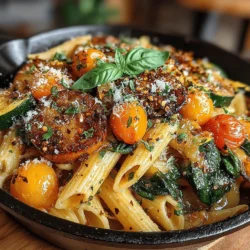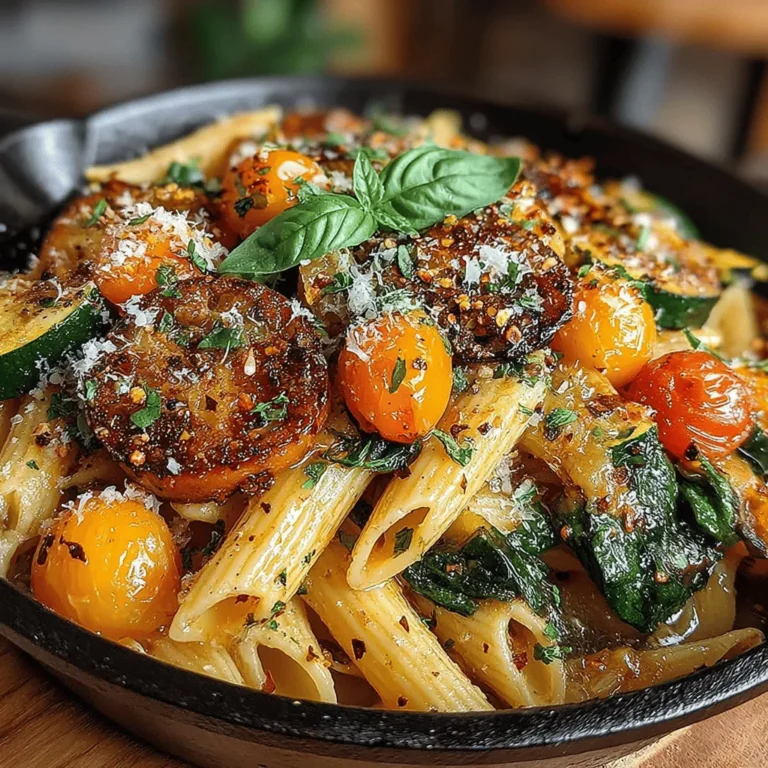Fresh Tomato Basil Veggie Pasta Skillet: A Healthy and Vibrant Dish
In a world where convenience often trumps nutrition, the Fresh Tomato Basil Veggie Pasta Skillet stands out as a beacon of wholesome eating. This recipe is not only easy to make but also packed with flavor and nutrients, making it an ideal choice for busy weeknights or serene weekend dinners. Featuring a colorful array of fresh vegetables, aromatic herbs, and whole wheat pasta, this dish provides a delightful culinary experience that caters to both the palate and the body.
The importance of incorporating whole foods into our daily meals cannot be overstated. Whole foods, which are minimally processed and free from artificial ingredients, are the cornerstone of a nutritious diet. They provide essential vitamins, minerals, and fiber that support overall health. The Fresh Tomato Basil Veggie Pasta Skillet exemplifies this principle, bringing together wholesome ingredients that not only satisfy hunger but also nourish the body. By choosing this recipe, you embark on a culinary journey that celebrates the vibrant flavors of fresh produce while embracing the health benefits of a balanced diet.
One of the standout features of this dish is its harmonious blend of flavors and textures. The tender pasta serves as the perfect backdrop for the crisp vegetables, while the fragrant basil ties everything together with its aromatic notes. Each bite offers a delightful contrast between the softness of the pasta, the crunch of the veggies, and the burst of flavor from the herbs. This balance is not only pleasing to the taste buds but also visually appealing, making the Fresh Tomato Basil Veggie Pasta Skillet a feast for the eyes as well.
The Health Benefits of Whole Wheat Pasta
At the heart of this dish is whole wheat pasta, a healthier alternative to traditional refined pasta. Whole wheat pasta is made from whole grains, retaining the bran and germ that are often stripped away in the refining process. This means that whole wheat pasta is richer in essential nutrients, including B vitamins, iron, magnesium, and zinc.
Incorporating whole grains into your diet is vital for maintaining a balanced nutritional profile. Whole wheat pasta offers a multitude of health benefits, particularly when it comes to dietary fiber. Fiber is crucial for healthy digestion, helping to regulate bowel movements and prevent constipation. Moreover, it plays a significant role in heart health by helping to lower cholesterol levels and stabilizing blood sugar. By choosing whole wheat pasta for your Fresh Tomato Basil Veggie Pasta Skillet, you not only enhance the dish’s nutritional value but also support long-term health goals.
Fresh Ingredients: The Stars of the Dish
The success of the Fresh Tomato Basil Veggie Pasta Skillet hinges on the quality of its ingredients. Utilizing fresh, seasonal vegetables not only elevates the dish’s flavor but also brings a wealth of nutrients to the table. The vibrant colors of bell peppers, zucchini, and tomatoes make this dish visually appealing, while the nutrients they provide contribute to a well-rounded meal.
Garlic and onions are the foundational aromatics, infusing the dish with a depth of flavor that sets the stage for the other ingredients. Their savory notes enhance the overall taste profile, making each bite more satisfying. Bell peppers and zucchini add a delightful crunch and a variety of vitamins, including vitamin C and potassium, which are essential for immune function and heart health.
Spinach and tomatoes are another dynamic duo in this dish. Spinach is a powerhouse of nutrients, packed with vitamins A, C, and K, as well as iron and calcium. Tomatoes are not only rich in antioxidants, particularly lycopene, but they also provide a juicy burst of flavor that complements the other ingredients perfectly. The impact of fresh herbs, particularly basil, cannot be overlooked. Basil brings a fragrant, slightly sweet taste that elevates the dish and enhances its overall freshness.
Recipe Breakdown: Step-by-Step Instructions
Now that we’ve explored the benefits and ingredients of this delicious dish, let’s dive into the step-by-step instructions for making your own Fresh Tomato Basil Veggie Pasta Skillet.
Step 1: Cooking the Pasta
To achieve the perfect al dente texture, start by bringing a large pot of salted water to a rolling boil. The salt is essential for seasoning the pasta as it cooks. Once the water is boiling, add your whole wheat pasta of choice—spaghetti, penne, or fusilli all work wonderfully. Stir the pasta occasionally to prevent it from sticking together.
Cook the pasta according to the package instructions, usually around 8 to 12 minutes, depending on the type. For al dente pasta, taste a piece a minute or two before the suggested cooking time is up; it should be firm yet tender. Once the pasta reaches this desired texture, reserve a cup of pasta water for later use. Then, drain the pasta in a colander and rinse it briefly under cold water to stop the cooking process. This step also helps to remove excess starch, ensuring that the pasta remains light and fluffy.
Step 2: Sautéing the Vegetables
While the pasta cooks, heat a generous drizzle of olive oil in a large skillet over medium heat. Once the oil is shimmering, add finely diced onions and minced garlic. Sauté them for about 2 to 3 minutes until they become fragrant and translucent. This creates a flavorful base for the rest of the ingredients.
Next, add diced bell peppers and zucchini to the skillet. Sauté these colorful vegetables for another 4 to 5 minutes, allowing them to soften while retaining a slight crunch. The goal is to enhance their natural sweetness while ensuring they provide texture to the dish.
Step 3: Incorporating Spinach and Tomatoes
Once the bell peppers and zucchini are tender, it’s time to incorporate the star ingredients—fresh spinach and ripe tomatoes. Add a handful of fresh spinach to the skillet, stirring gently until it wilts, which should take just a minute. Then, add diced tomatoes, allowing them to cook down slightly and release their juices. This will create a rich sauce that coats the pasta beautifully.
At this point, you can also add a pinch of salt and pepper to taste, adjusting the seasoning based on your preference. If the mixture appears too dry, consider adding a splash of the reserved pasta water to help bring everything together.
Stay tuned as we continue to build on this delightful dish, exploring additional steps and tips to make your Fresh Tomato Basil Veggie Pasta Skillet a true culinary masterpiece.
{{image_2}}
Sautéing Aromatics
The foundation of any great dish lies in the careful sautéing of aromatics—garlic and onions in this case. Begin by heating a generous amount of olive oil in your skillet over medium heat. Add finely chopped onions first, allowing them to soften and become translucent, which typically takes about 3-4 minutes. This step is crucial as it releases their natural sweetness, creating a flavorful base for your dish.
Once the onions are ready, add minced garlic. Sauté the garlic for an additional 1-2 minutes until it turns fragrant but be careful not to let it burn, as burnt garlic can impart a bitter taste to your dish. The aromatic blend of onion and garlic sets the stage for the vegetables to shine in your Fresh Tomato Basil Veggie Pasta Skillet.
Adding Vegetables
Next, it’s time to bring in the colorful array of vegetables. For this recipe, consider using bell peppers, zucchini, and carrots for their vibrant colors and crunch. When adding these vegetables to the skillet, ensure they are cut into uniform pieces to promote even cooking.
To retain the color and crunch of the vegetables, follow this technique: Add the vegetables in stages, starting with the ones that take longer to cook. For example, bell peppers can go in first, followed by zucchini and carrots a couple of minutes later. Sauté them for 5-7 minutes until they are tender yet crisp. This method helps to lock in their bright colors and ensures they have the perfect bite, enhancing both the visual appeal and texture of your dish.
Folding in Tomatoes and Spinach
Now, let’s incorporate the stars of the show: fresh tomatoes and spinach. After your sautéed vegetables have reached the desired tenderness, it’s time to add the chopped tomatoes. Use ripe tomatoes for the best flavor, and let them soften in the skillet for about 3-4 minutes. As they break down, they will create a delicious sauce that melds beautifully with the sautéed vegetables.
Once the tomatoes are slightly softened, gently fold in the fresh spinach. The residual heat will wilt the spinach in just a minute or two. Timing is key here; overcooking spinach can lead to a loss of its bright green color and nutrients. You want the spinach to be tender but still vibrant, maintaining its nutritional value and visual appeal.
Combining with Cooked Pasta
At this point, your pasta should be perfectly al dente, ready to be combined with the sautéed vegetable mixture. When draining your pasta, be sure to reserve about a cup of pasta cooking water. This starchy water is a secret weapon for achieving the right consistency in your dish.
Add the drained pasta directly to the skillet with the sautéed vegetables. Begin tossing everything together, and if the mixture seems dry, gradually add the reserved pasta water, a few tablespoons at a time. This step helps to create a cohesive dish, allowing the flavors to intermingle while keeping the pasta moist and flavorful.
Seasoning and Finishing Touches
The final step in perfecting your Fresh Tomato Basil Veggie Pasta Skillet is to season it generously. Start with a sprinkle of salt and pepper to taste. Since the dish relies heavily on fresh ingredients, taste as you go, allowing the flavors to guide your seasoning adjustments.
To elevate the flavor profile further, add freshly chopped basil right at the end. Basil complements the tomatoes beautifully and adds a fresh, herbaceous note to the dish. If you’re looking for a richer finish, consider topping your skillet with grated Parmesan or a vegan cheese alternative for a creamy texture that balances the freshness of the vegetables.
Serving Suggestions
When it comes to presenting your Fresh Tomato Basil Veggie Pasta Skillet, let your creativity shine. Serve it directly from the skillet for a rustic, family-style meal, or plate it individually for a more refined presentation.
Consider garnishing each serving with additional fresh basil leaves and a drizzle of high-quality olive oil for a touch of elegance. For added crunch, sprinkle some toasted pine nuts or walnuts on top. Pair the dish with a simple side salad or crusty whole-grain bread to round out your meal.
Flavor Variations and Customizations
One of the joys of this Veggie Pasta Skillet is its versatility. You can easily customize it based on seasonal vegetables or your personal preferences. Here are some suggestions:
– Seasonal Vegetables: In spring, consider adding asparagus or peas; during summer, zucchini and bell peppers shine; in fall, roasted butternut squash or kale would be delightful.
– Protein Additions: For those looking to boost the protein content, grilled chicken or shrimp can be added for a heartier meal. Alternatively, for a plant-based protein source, toss in some chickpeas or cooked lentils.
– Spice Adjustments: If you enjoy a bit of heat, consider adding red pepper flakes or a dash of cayenne pepper. Conversely, for a milder flavor, you can omit any spicy elements altogether.
– Vegan Alternatives: If you prefer to keep the dish dairy-free, nutritional yeast can serve as a fantastic substitute for cheese, providing a cheesy flavor without the dairy.
Nutritional Information
This Fresh Tomato Basil Veggie Pasta Skillet is not only delicious but also nutritious. Each serving provides an approximate breakdown of:
– Calories: 350
– Protein: 12g
– Fats: 10g
– Carbohydrates: 55g
– Fiber: 6g
This dish fits seamlessly into various dietary preferences, including vegetarian, vegan, and gluten-free options (just use gluten-free pasta). Packed with vegetables, it offers a wealth of vitamins and minerals, making it a wholesome choice for any meal.
Conclusion
The Fresh Tomato Basil Veggie Pasta Skillet is an ideal representation of a quick, nutritious, and delicious meal that can be whipped up in under 30 minutes. With its vibrant colors, fresh flavors, and wholesome ingredients, it’s a dish that not only satisfies the palate but also nourishes the body.
Incorporating more vegetable-rich meals into your daily cooking is a wonderful way to embrace a healthier lifestyle. This recipe serves as a reminder of the joy of cooking with fresh ingredients and the pleasure that comes from sharing meals with loved ones. So gather your ingredients, embrace the flavors of the season, and enjoy this delightful pasta skillet any night of the week.


